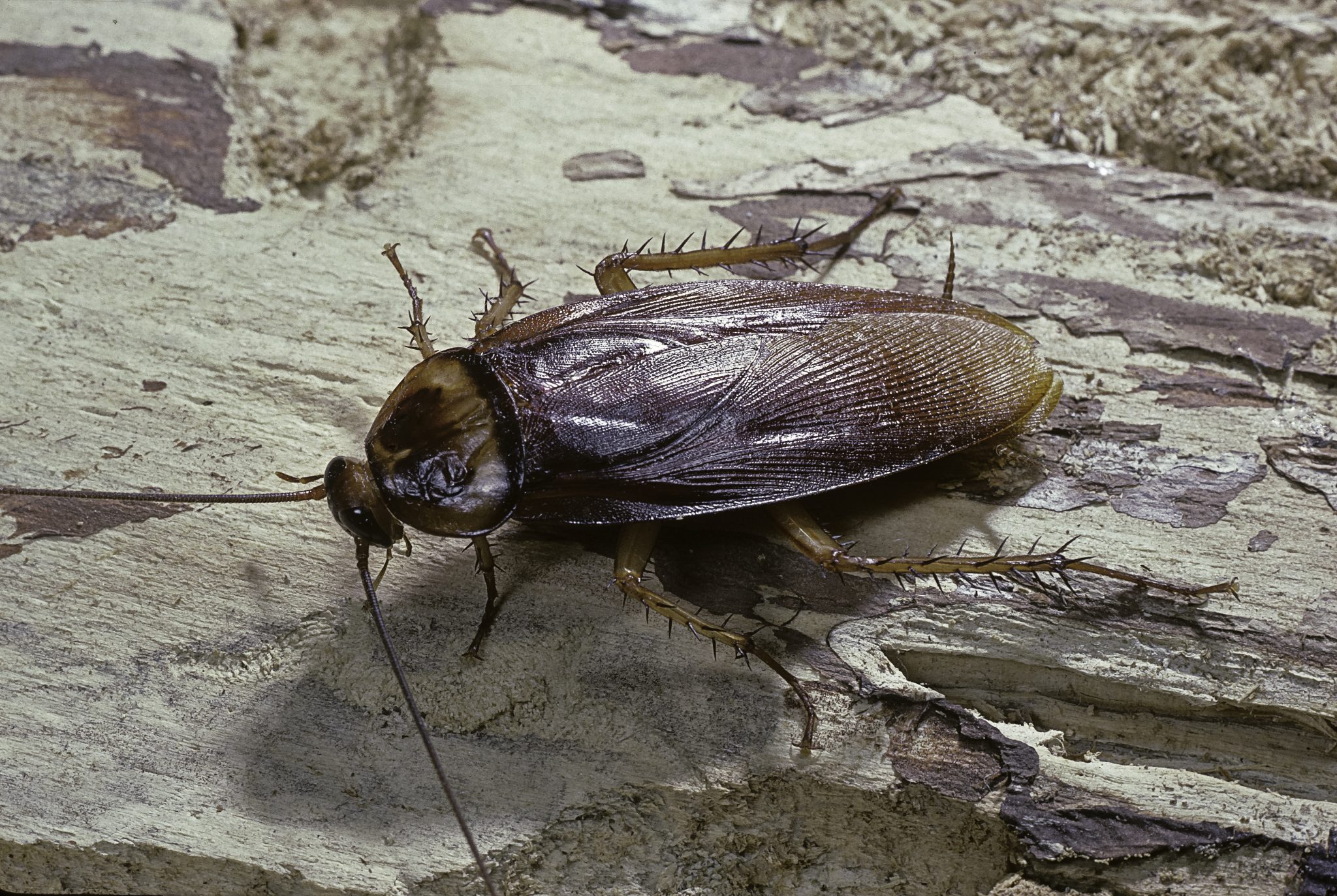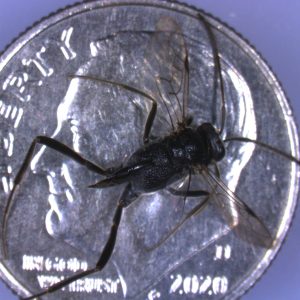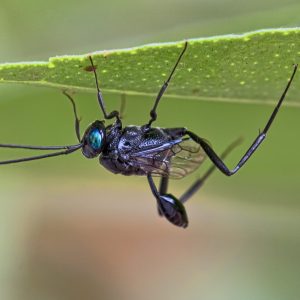Home

Biological control offers an organic way to eliminate cockroaches by using their natural enemies against them—reducing the need for potentially harmful pesticides in the process. Learn biocontrol options that are safe and effective in controlling cockroach infestations.
Pest cockroaches are frequent trespassers in homes and businesses. Infestations can spoil food, damage property, and endanger human health through the spread of allergens and diseases. Pest cockroaches can be split into two broad categories: domestic and peridomestic. Domestic cockroaches rely heavily on humans for food and shelter and are the most likely to infest homes and restaurants. Examples include the German and brown-banded cockroaches. Peridomestic cockroaches can survive without humans but often move into buildings when conditions outdoors become poor (i.e., droughts, winter). Examples include the American, smokybrown, and Oriental cockroaches.
The Case Against Chemical Control
Pesticides are often the go-to treatment when dealing with cockroaches and other insect pests, particularly if the house is old and full of cracks and crevices that make sanitation and habitat elimination unfeasible. Pesticides, however, may not always be the best solution. The target pest may be resistant to the pesticide’s ingredients, which is often the case with the German cockroach. Conditions in the treated area may cause the pesticide to quickly degrade, or the treatment may be unable to kill all of the pest’s life stages (i.e., eggs and pupae). Pesticides also are not a precise tool. They must either draw in the target pest with bait or be applied in an area near the pest.
Pesticides will kill both pests and beneficial species. Many pesticides also pose a risk to the health of humans and pets if used improperly. Some even require training and a license to apply.
The Case for Biological Control (Biocontrol)
Biological control offers a way to work around and reduce many of the concerns associated with chemical pesticide use. Biocontrol is a method of managing pests by using their natural enemies. These enemies include predators, parasites, and diseases that attack pests in the wild. For example, a gardener may release ladybugs, which are a natural enemy of aphids, to help control an infestation of their vegetables.
Biocontrol comes with some challenges. It is a slow process in reducing pest numbers, and some biocontrol organisms are vulnerable to environmental conditions. Despite this, biocontrol minimizes safety concerns and can be used as a more precise tool for controlling the selected pests. There is little to no risk that the target pest will develop resistance to a biocontrol agent. A natural enemy species can be established as a long- term or permanent treatment tool, and most biocontrol organisms will move about without assistance to hunt the target pest.
Biocontrol management plans can be tailored to address the gaps left by other methods. For instance, pesticides applied inside the home may kill a cockroach infestation, but they do not affect the cockroaches living in neighboring homes or outdoors. Natural enemies released into the area can reduce the chance of reinfestation by killing the target pests across a wider area.
Care must be taken when using a combination of pest control methods; they may interfere with the effectiveness of the biocontrol organisms. Careful planning before the use of a biological control program can help ensure that the chosen natural enemies are at their most effective levels.
Biocontrol Options for Cockroaches
Cockroach Oothecal Parasitoids
Cockroaches have several groups of natural enemies that can be used for control. Among these are parasitoid wasps that attack both domestic and peridomestic cockroach egg cases (oothecae). This does not include German cockroaches, for which there is currently no known parasitic wasp.
Parasitoid wasps function differently than microparasites in that they kill the host after completing development. Three species of egg case parasitoid wasps have been developed into cockroach biocontrol agents and can be found living in the wild throughout most of the United States:
- Aprostocetus hagenowii (figure 1) attacks most large peridomestic cockroaches. This includes American, Oriental, Australian, brown, and smokybrown cockroaches.
- Comperia merceti (figure 2) attacks only brown- banded cockroaches.
- Anastatus tenuipes (figure 3) attacks only brown- banded cockroaches.
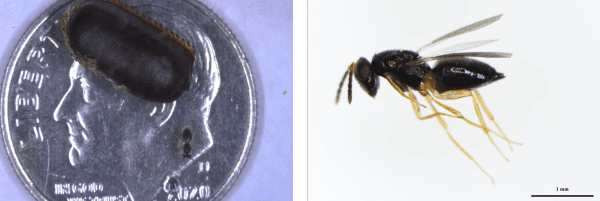
Figure 1. A. hagenowii wasp and an American cockroach egg case (left); female A. hagenowii (right)
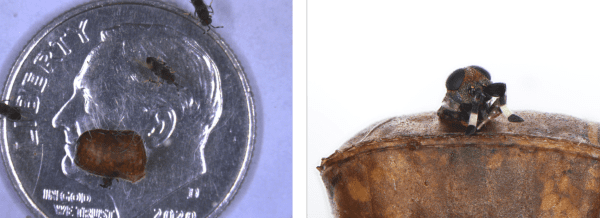
Figure 2. Three C. merceti wasps and a brown-banded cockroach egg case (left); female wasp with white bandings across antennae emerging from cockroach egg case (right). Note that parasitized brown-banded cockroach egg cases have white or black contents visible through the shell. Unparasitized egg cases develop a green coloration.

Figure 3. Two A. tenuipes wasps and a brown-banded cockroach egg case (left); a female A. tenuipes (right)
All three wasp species are very small (1/10 inch; less than or equal to 3 millimeters), harmless to humans, pets, and plants, and will seek out cockroach egg cases on their own.
Evania appendigaster (figure 4) and Prosevania fuscipes are two large egg case parasitoids (about 1/3 inch; 1 centimeter) that sometimes make their way into homes and buildings. These two wasp species are similar in appearance, with black coloration and long hind legs. The latter, however, has reddish brown legs. They also have similar abdominal movements that resemble a flag waving up and down on a short pole (figure 5). Wild populations of these wasp species exist throughout the United States. Egg case wasps currently are not commercially available for purchase.
- Figure 4. E. appendigaster wasp
- Figure 5. An E. appendigaster wasp waves her abdomen in a flaglike fashion. (Photo credit: Dani Barcha, UGA, Bugwood)
Predatory Nematodes
Predatory nematodes are parasitic roundworms that invade insects and poison their bloodstream. A new generation of nematodes then emerges from the dead insects and seeks out more hosts. The nematode Steinernema carpocapsae (often shortened to Sc) is the most widely available species for those seeking to control peridomestic cockroaches.
Once applied to the soil, the nematodes attack a wide variety of insects, including fleas, maggots, caterpillars, mole crickets, and beetles. Nematode applications are limited to warmer seasons of the year and require the soil to be moistened at the time of application. A single application may be effective throughout the year under suitable conditions and in milder climates. Predatory nematodes pose no danger to plants, pets, or humans.
To purchase, visit the websites of Arbico Organics, Grow Organic, Hirt’s Gardens, or Nature’s Good Guys.
Entomopathogenic Fungi
The term entomopathogenic comes from the Greek words for insect (entomon) and illness (pathos). It is used to describe the organisms that cause disease in insects.
Two species of fungi, Beauveria bassiana and Metarhizium anisopliae, have been developed into products widely available for general insect control. The two species can be differentiated by color. Insects infected with B. bassiana typically have puffy white growths developing from body and leg joints. Insects infected with M. anisopliae look like they are coated in a thick green powder. These fungi are most often used to control pests in fields, greenhouses, and gardens. Indoor and laboratory studies have shown that they are capable of significantly reducing pest cockroach populations. When using either of these fungi indoors, special considerations must be made because they may infect pet reptiles.
To purchase, visit the websites of Arbico Organics or Do My Own.
Conclusion
The use of a biocontrol method alone is unlikely to exterminate a cockroach infestation. Biocontrol performs best when used as part of an integrated pest management plan (IPM) that includes pesticides, sanitization, etc., tailored to control a given pest. For example, an apartment complex may control an American cockroach infestation by keeping the dumpster area free from loose garbage and regularly emptied, treating the soil with nematodes, and applying a pesticide barrier on the outside perimeter of each building to keep cockroach numbers low and out of homes. In another example, a city park may release parasitoids near drains and manholes to attack the egg cases located in hard-to-reach areas, while insecticide bait stations are used near trash cans and bathrooms.
Biocontrol is best suited to outdoor pest management. While the organisms are generally harmless, they should not be used in areas such as restaurants where they may contaminate food or disturb customers. If using biocontrol inside a home, ensure that the residents are well informed and agree to its use. Contact your county Extension office for help in developing an IPM plan to suit your needs.
 Chelsea Smith, PhD student, Arthur Appel, Professor, and Xing Ping Hu, Extension Specialist and Professor, all in Entomology and Plant Pathology, Auburn University
Chelsea Smith, PhD student, Arthur Appel, Professor, and Xing Ping Hu, Extension Specialist and Professor, all in Entomology and Plant Pathology, Auburn University
New January 2022, Cockroach Biocontrol: Parasitoids and Parasites, ANR-2778

